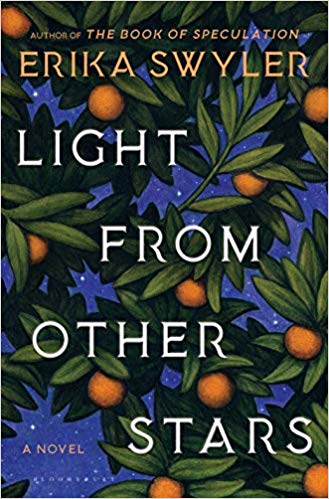Interviews
If We Leave Earth, a Lot of Bullshit Will Fall Away
In Erika Swyler’s "Light From Other Stars," a tiny crew of space explorers tries to do humanity right

As Earthbound creatures, we might be forgiven for finding the universe—with its infinite distance, infinite space, infinite unknowability—a bit daunting. We are an explorer species, but exploration has historically proven to be dangerous work, both literally and morally so, provoking death, illness, and colonial bias in equal measures. If such perils can be found on Earth, what might we find in blackest space?
The wonderful thing about Erika Swyler’s new novel Light From Other Stars is the way it turns this question its head. What if, the novel dares to ask, a voyage into outer space was joyous? What if the things we found in space were liberty and equality?
Swyler’s book moves between two storylines, one set aboard the spacecraft Chawla, whose crew of four is on a mission to terraform a new planet in advance of settlers from the degrading Earth—and another that follows the young Nedda Pappas (also a Chawla crew member, as an adult) and her family in the town of Easter, Florida, over the course of a peculiar few days during which they become trapped in a bubble of time.
If that sounds far-flung, the story’s greatest success is how deeply human it is, no matter the setting—a hallmark of the best science fiction: it remembers that, no matter where we go, there we are. I read Light From Other Stars (hereafter LFOS) twice in preparation for this interview, and cried both times; I was therefore delighted to talk with Erika about science, family, and literary structure—all of them, for both of us, matters of the heart.
AC: Let me start with a question that may seem easy, but which sat with me often while I was reading LFOS. What is the genesis of the names in this book? From human names—Nedda, Betheen—to machine designations—Chawla, especially—everything feels precisely selected, very oriented in place and time. Was your process for this intuitive, or driven by specific goals?
ES: For me, naming is equal parts gut and design. There has to be something fun to a name because I’m a slow writer and I’m going to have to live with it for a few years. It also has to feel organic to the world. I think about Flannery O’Connor, and how her names are so deeply rooted in place: there’s no way anyone named June Star is from Greenwich, Connecticut. Betheen’s name had to conjure a particular type of woman, polished, but just about to fray, and it needed to have musicality. This applied to Nedda, though I was thinking more scientifically about her. When you get to small parts of the atom, you get all these fun names–quark, gluon, muon—and I wanted something that felt like it fit in that world. To me, Nedda sounds like both a girl and a subatomic particle. As for other people populating the world, well, you can’t write 1980s America without at least one Tiffany.
It’s important to me that when I consider space and the future, it’s not white and male. That’s not what’s in the universe.
When it comes to naming objects, on the other hand, it’s almost all logic. The bots and rovers had to reflect different languages because space exploration has always been multi-national. Chawla was an important choice for me. I needed to name against the whiteness of space exploration. Kalpana Chawla was an engineer who died when the shuttle Columbia broke apart. She was the first Indian-American woman in space. And while we name things for our heroes, we also name for ideals. It’s important to me that when I consider space and the future, it’s not white and male. That’s not what’s in the universe. The universe is beyond vast, and by our narrow definitions of gender and sexuality, it’s nonbinary and queer as hell.
AC: I love that. Let’s talk more about the science in this book, which is so vital—not just in the sense of being important to the plot, but in the sense of living and breathing alongside the characters, each of whom is a vehicle for a very different class of knowledge. Can you talk about how you approached the research for this book—what you knew going in, how you tailored your learning, etc.? I’m especially curious if you can talk to how you designed the Crucible, which is so vivid as a physical object, as well as its more, um, energetic qualities.
ES: I wanted to approach science in the way readers are accustomed to approaching magic. Most of us know a phrase or two of butchered Latin and what shouting it while holding a wand is supposed to do: fewer of us know why a strike-anywhere match works, even though we use it to literally carry fire with us. That lack of curiosity troubles me, not because we see magic as more interesting or fun than the sciences, but specifically because the physical world is magic. The less curious we are about it, the greater the likelihood that we lose it. I feel a responsibility to speak to curiosity, so that led to research, but nothing overly strenuous—novelists tend to fetishize research in a way that’s unhealthy for the form. Most of the work was reverse engineering. I’d write what I needed something to do, then find the science that did it. That’s no different from research for almost any other novel. We’ve been taught as a culture, wrongly, that science and math are extremely difficult and esoteric, but it’s more that so much science has been explained to us very, very badly. There’s almost no science in the book that’s outside the realm of a high school education, because most of it needed to be understandable to a smart preteen, and high school is, for many of us, when formal science education ends—myself included.
In designing Crucible, the entropy machine, it came down to how to represent chaos. I remember the day in physics when we learned about heat death, everyone left the class in silence. There is an “I just learned about entropy and heat death” face; it’s a mixture of wonder, horror, and the realization that you are incredibly small. I wanted that in Crucible. It needed to sound beautiful, but also a bit terrifying. For me that means glass, gold, and spiders. And I knew it had to spin because centrifugal force is one of those aspects of physics we all recognize. Spinning is physical, visceral. As for how it works—there’s a theory that spacetime behaves like a fluid, and when I’m writing about something as intangible as time, I jump on every way I can to physically represent it.
AC: Nedda is a young girl for much of the book, and I love how much she wants things: she wants the monkey she sees in the truck bed, she wants her dad’s attention, she wants all of Mr. Pete’s NASA memorabilia, she wants to go to space. She’s never afraid to name her wanting, at least to herself, and I found that to be a quietly magnificent portrayal of girlhood.
In addition, we also see Annie’s desperation for a moment alone, and Betheen’s ambition (frustrated but palpable and deserved), and Marcanta’s casual sexuality…it all adds up to a fascinating portrait of women desiring things, and reckoning with the fallout from that desire. Not everyone gets what they want. Not everyone wants the same thing. But everyone is pushing and pulling against the boundaries of what they need and what their circumstances allow. Did you set out to portray that, or did it emerge naturally from your characters?
ES: We’re still at a point where we can’t write women without also writing what’s been forbidden to us. So while it may not have been my goal at the outset, it was unavoidable. When writing a young girl, you think and write about emotions much more intensely, because they haven’t had their edges dulled: each desire is totally novel and also seems possible, because managing expectations is one of aging’s coping mechanisms. Children’s wants are stronger. As I dug in, I got fixated on what dulled those edges and saw that so much of it was tied to gender, specifically what girls and boys are allowed to be excited about. Our desires and enthusiasm get gendered and directed during the preteen years. Yes, lots of people fight it, but rarely without repercussion. I got to thinking about widows and divorcees I’ve known, women who blossomed once they were on their own. It’s more complex than their husbands holding them back. Women typically have to push down one set of desires in order to pursue another. So it became important to juxtapose Nedda—who wants things and doesn’t understand compromise—with her mother, Betheen, who had enormous professional ambition but got forced into a different shape. Each form of desire has a cost.
In space, in the future chapters, the characters had to behave differently when it came to sex and affection. Not just because I’m hopeful that conventions will change, but because in a society of four there’s no hiding. For the same reason, it was important that the men in the crew, Amit and Evgeni, actually communicate emotion, that they’re affectionate in ways men haven’t been allowed. The four are entirely reliant on each other for happiness—for everything. I know it’s naïve, but I like to think that if we leave Earth, a lot of bullshit will fall away.
AC: That leads perfectly into my next question. LFOS is full of different kinds of families: Nedda’s immediate family, her “government of four” aboard Chawla, her near-sibling friendship with Denny. Can you talk about how you developed these different pictures of functional intimacy? The Chawla family, in particular, strikes me as nearly utopian—except that it only functions the way it does because it’s so very small. What does this say, for you, about how humans relate, especially at this point in time? Why does space seem like fertile ground for a utopian connection?
ES: Functional intimacy means mutual reliance. I start there. Nedda needs someone who likes her intelligence, and doesn’t expect her to be anything other than who she is. Denny needs someone who is up for adventure, who doesn’t care who his dad is, and who is a safe person. These are basic needs that don’t change over time. Absent external forces, needs being met is the foundation of intimacy. Without mutual reliance, intimacy breaks, which is where Betheen and Theo are.
Large-scale utopias don’t work in part because of these same ideas of reliance and intimacy. Nations operating as individuals cause conflicts. Individuals operating without concern for group tank entire social systems. In the U.S., we’ve built this strange cult around self-reliance and it’s not working out well, because every glitch of personality becomes catastrophic when translated to a global scale.
Space seems like our best chance at creating utopias.
Space seems like our best chance at creating utopias, because we can only send so many people up, and we’re very careful about who we send. They can’t want to kill each other, they need to be able to cope with isolation, bad food, tight quarters, and the very real threat of death. They’ve got to have a strong sense of altruism. When you listen to astronauts speak, that hope is infectious, it’s the thing that makes utopias. We send people into space to live and work as a group, for the good of a group, and they’ll rely on each other or die. Manned space missions are examples of total human interdependence that exist outside the individualist bravado we’ve cooked up on Earth. There’s something profoundly hopeful in the thought of a tiny little society setting out to try to do this humanity thing right.
AC: I keep thinking about how, in the book, desire is so frequently an imperfect vehicle for success. For example, Betheen wants very sincerely to be a mother, to do science, for Nedda to love her—but her wanting is insufficient to achieve those ends, however noble they may be. Her desire only becomes clearer when viewed through the lens of responsibility—what Nedda needs; what will save the town—and I think this is true for Nedda, too, when she grows up. Her trip to outer space is not a joyride.
So here is my last question for you, which is as much a question about life as you see it as it is a question about the book: can we achieve anything when we achieve it just for ourselves? Or will we always be too perilously shortsighted, if we are not responsible for a little bit more?
ES: You’ve hit on my feelings about the razor edge of ambition. Ambition is important and we all have it, but it never leaves us where we expect, and we’re always struggling to reframe. That’s so much of Betheen as a character. I suppose I don’t believe there is any achievement that’s just for the self. Our egos are far too large and too fragile to do anything that’s just a personal achievement. When we can’t find a living person achieve something for, we haul up the dead and achieve things in memory of loved ones. We can’t escape our need to feel important, which is always in dialog with group and responsibility. Also, the ego isn’t strong enough to overcome the need for meaning, and meaning demands a world outside the self. Even with writing fiction, we tell ourselves it’s fine if no one reads it, that it’s something just for us. But it doesn’t feel that way, does it? We write to engage, to make people think. That is a kind of responsibility. Problems arise not necessarily from ambition or a desire to achieve things just for the self, but from the failure to realize the ways we are, and hunger to be, tied to the world. I need books and characters to confront that interconnectedness of things. We all start out perilously short-sighted. The human journey is finding responsibility, which is making meaning through finding group.









